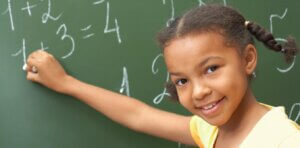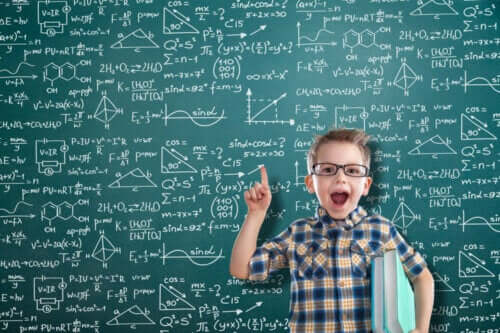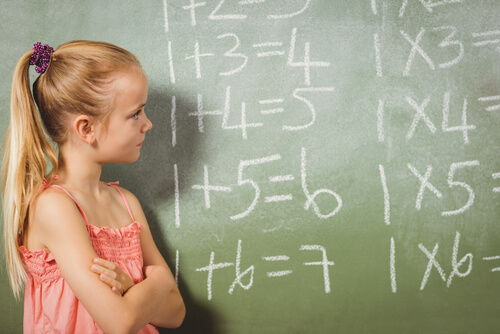Mental Math Exercises for Elementary Students

Mental math is a basic skill that we have to learn and exercise because we use it every day. We use it to carry out various actions, and we might not even realize it. Since it’s so important, here we’ll show you some mental math exercises for elementary students to help your children at home.
Mental calculation is a basic skill that we have to learn and exercise, both in school and at home. That’s why it’s so important that our children learn this skill.
Mental math
Mental math exercises include different strategies that are based on the properties of the number system and arithmetic operations. It involves doing math using only our brains, without needing to resort to any other tools, like a pencil, paper or a calculator.

Once students get to a certain age in school, they have to learn to do simple mathematical calculations. Then, they’ll progressively advance towards more complex ones. To do that, you have to start with a basic understanding of numbers.
Also, you have to learn how numbers can be changed into different parts and in different ways. This allows you to use different mental math strategies, which will increase your mental agility.
Mental math exercises for elementary students
Now, we’ll share some examples of mental math exercises for elementary students. These are simple mathematical exercises that your child can work on at school or at home.
- What number is missing?
Children have to use their mental math to find the missing number in different equations. The number and the type of problem will depend on the student’s age and level of education. As they get older, they’ll progressively learn more.
Example: 5+?=13; 15+?=25.
- Look for more than one way to do it.
This one has students looking for more than one way to solve a problem.
Example: Two numbers that add together to get 100 (70+30 0r 80+20).
- Find the imposter
In number series, the children work to find the error. So, they’re looking for the number that doesn’t belong because it doesn’t follow the same pattern.
Example: 2, 4, 6, 8, 9, 12, 14, 16 or 10, 9, 5, 7, 6, 5, 4, 3, 2, 1.
- Swap the numbers.
Mental math exercises are easier when the first number in the equation is greater than the second. It’s easier to teach children when they have to add the smallest number to the largest.
Example: Instead of adding 8 = 21, add 21 + 8. This makes the mental math easier, and we get the answer 29.
Other mental math exercises for elementary students
Which of these two is closest?
Write pairs of different numbers on a piece of paper, each in groups of two numbers. Then, on another sheet of paper, write individual numbers and have your child cut them out and put them in a jar. Your child will then draw a number from the jar and calculate mentally to see which number from the pairs on the first sheet is the closest to it.

Playing dice
This is another mental math exercise that your child can do at home with the family or that they can do at school in small groups. For this activity, you’ll need two dice. You play by throwing the dice and calculating the sum of the dots on both dice. While other players wait their turn, they’ll check for accuracy in the calculations and will keep track of points.
Consecutive adding
This exercise helps to mentally add two consecutive numbers. Consecutive numbers are numbers that follow each other in order. To do this exercise, it’s easier to teach your little ones to think of twice the smaller number, then add one.
Example: to add 7 + 8, add 7 + 7 and then add one more to the sum. So, the first sum is 14, then you add 1 to get 15. Or, to add 8 + 9, add 8 + 8 to get 16, then add 1.
Mental math is a basic skill that we have to learn and exercise because we use it every day. We use it to carry out various actions, and we might not even realize it. Since it’s so important, here we’ll show you some mental math exercises for elementary students to help your children at home.
Mental calculation is a basic skill that we have to learn and exercise, both in school and at home. That’s why it’s so important that our children learn this skill.
Mental math
Mental math exercises include different strategies that are based on the properties of the number system and arithmetic operations. It involves doing math using only our brains, without needing to resort to any other tools, like a pencil, paper or a calculator.

Once students get to a certain age in school, they have to learn to do simple mathematical calculations. Then, they’ll progressively advance towards more complex ones. To do that, you have to start with a basic understanding of numbers.
Also, you have to learn how numbers can be changed into different parts and in different ways. This allows you to use different mental math strategies, which will increase your mental agility.
Mental math exercises for elementary students
Now, we’ll share some examples of mental math exercises for elementary students. These are simple mathematical exercises that your child can work on at school or at home.
- What number is missing?
Children have to use their mental math to find the missing number in different equations. The number and the type of problem will depend on the student’s age and level of education. As they get older, they’ll progressively learn more.
Example: 5+?=13; 15+?=25.
- Look for more than one way to do it.
This one has students looking for more than one way to solve a problem.
Example: Two numbers that add together to get 100 (70+30 0r 80+20).
- Find the imposter
In number series, the children work to find the error. So, they’re looking for the number that doesn’t belong because it doesn’t follow the same pattern.
Example: 2, 4, 6, 8, 9, 12, 14, 16 or 10, 9, 5, 7, 6, 5, 4, 3, 2, 1.
- Swap the numbers.
Mental math exercises are easier when the first number in the equation is greater than the second. It’s easier to teach children when they have to add the smallest number to the largest.
Example: Instead of adding 8 = 21, add 21 + 8. This makes the mental math easier, and we get the answer 29.
Other mental math exercises for elementary students
Which of these two is closest?
Write pairs of different numbers on a piece of paper, each in groups of two numbers. Then, on another sheet of paper, write individual numbers and have your child cut them out and put them in a jar. Your child will then draw a number from the jar and calculate mentally to see which number from the pairs on the first sheet is the closest to it.

Playing dice
This is another mental math exercise that your child can do at home with the family or that they can do at school in small groups. For this activity, you’ll need two dice. You play by throwing the dice and calculating the sum of the dots on both dice. While other players wait their turn, they’ll check for accuracy in the calculations and will keep track of points.
Consecutive adding
This exercise helps to mentally add two consecutive numbers. Consecutive numbers are numbers that follow each other in order. To do this exercise, it’s easier to teach your little ones to think of twice the smaller number, then add one.
Example: to add 7 + 8, add 7 + 7 and then add one more to the sum. So, the first sum is 14, then you add 1 to get 15. Or, to add 8 + 9, add 8 + 8 to get 16, then add 1.
All cited sources were thoroughly reviewed by our team to ensure their quality, reliability, currency, and validity. The bibliography of this article was considered reliable and of academic or scientific accuracy.
- Ortega del Rincón, T., y Ortiz Vallejo, M. (2002). Cálculo Mental. Departamento de Análisis Matemático y Didáctica de la Matemática. UNIVERSIDAD DE VALLADOLID. Recuperado de http://www.seiem.es/docs/educacion/CM1ciclocompleto.pdf
- Cerón, C. H., y Gutiérrez, L. V. (2013). La construcción del concepto de número natural en preescolar: una secuencia didáctica que involucra juegos con materiales manipulativos. Recuperado de http://funes.uniandes.edu.co/11265/1/Cer%C3%B3n2013La.pdf
This text is provided for informational purposes only and does not replace consultation with a professional. If in doubt, consult your specialist.








